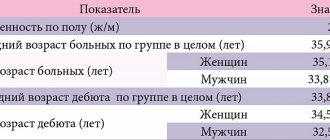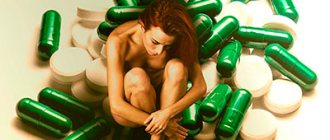One of the most “popular” antidepressants among doctors. According to our data, this medicine is one of the ten most frequently prescribed drugs by psychiatrists.
Escitalopram
is produced under many names: cipralex (considered the original, since it was the very first), elicea, esipi, escitalopram, selectra, lenuxin, miracitol, etc.
All of these are analogues, that is, drugs with the same active ingredient, but produced at different factories by different manufacturers.
The drug was obtained as a result of a “modification” of another antidepressant from the group of selective serotonin reuptake inhibitors (SSRIs) - citalopram.
The mechanism of action is associated with a decrease in the flow of the neurotransmitter serotonin back into the neuron after it has entered the intercellular space - the synapse.
The drug promotes the accumulation of serotonin in the synapse (the junction of neurons), and if the painful condition caused the depletion of serotonin, then long-term use of escitalopram leads to the restoration of serotonin metabolism and a decrease in the symptoms of the disease. The main effect is antidepressant and anti-anxiety.
Available in the form of film-coated tablets in a dosage of the active substance of 10 milligrams.
Indications for taking escitalopram
- Endogenous depression of mild to moderate severity.
- Panic attacks, panic disorder, generalized anxiety disorder, phobias.
- Organic anxiety and depressive disorders.
- Neuroses, neurasthenia, mixed anxiety and depressive disorder, somatoform disorders, psychosomatic diseases, prolonged reactive states (mental trauma, adaptation disorders).
- Alcohol and drug addiction, substance abuse.
The convenience of taking ecitalopram is that you do not need to adjust the dose (recommended - 10 mg / 1 tablet once a day
), rarely have side effects, according to psychiatrists it gives a positive effect in the vast majority of cases of use.
The disadvantages include the slow onset of the therapeutic effect over the course of a month, and a slight increase in anxiety in the first days of use (which is very inconvenient when treating panic attacks, phobias and anxiety disorders).
Contraindications
Before the appointment, the specialist examines the characteristics of the patient’s physical condition, clarifies information about the presence of other diseases in order to exclude contraindications.
The antidepressant is not recommended for use in the following cases:
- with hypersensitivity to the active component (escitalopram);
- during pregnancy and breastfeeding;
- in combination with MAO inhibitors, serotonergic drugs.
The use of Selectra in pediatrics is not practiced. The age limit for contraindications is up to 18 years.
The most frequently asked questions about the use of escitalopram
Is escitalopram addictive?
The drug does not cause dependence. Those cases when painful symptoms went away while taking escitalopram, but returned after discontinuation of the drug, do not indicate the formation of addiction, but about too early cessation of treatment or insufficient therapy.
Can I take it on my own?
No. Only after prescription by a doctor.
Can a psychologist prescribe escitalopram?
No. Like any antidepressant, like any medicine, this drug can only be prescribed by a doctor - a person with a higher medical education, then completed specialization (internship or residency) and has a valid doctor’s certificate.
Psychiatrists are the most knowledgeable about the treatment of depression and anxiety disorders and the effects of antidepressants. But doctors of other specialties can also prescribe antidepressants. The psychologist does not have a medical education and therefore cannot make such appointments. Read more about the difference between a psychologist, psychotherapist and psychiatrist here.
How and where can I purchase it? What does this require?
It is sold in pharmacies. To purchase it you will need to present a prescription from a doctor.
Does escitalopram contribute to suicidal behavior?
There is no such data. The described isolated cases of suicide while taking this drug were explained by the fact that there were risks of suicide even before the start of treatment. Suicide was a consequence of illness (depression, psychosis), and not the effect of the drug.
Is it possible to drink alcohol during treatment with escitalopram?
Drinking alcohol neutralizes the therapeutic effect of the medicine and worsens the general condition of the brain. Therefore, drinking alcohol during treatment is not advisable.
How long to take escitalopram?
Treatment with this antidepressant takes several months. The therapeutic effect usually develops in the first 3 months of treatment; further use usually prevents the recurrence of symptoms.
If indicated, long-term use is possible. Even if there are no complaints about the condition during therapy with escitalopram, you need to see a doctor at least once every 2-3 months. The duration and regimen of administration is determined by the attending physician. On average it is about 6 months.
Is it possible to replace escitalopram with a similar drug with a different name during treatment?
This question often arises due to the large difference in price for the same drug, produced by different manufacturers and having a different name. As experience shows, no changes occur with such a change. But if such a question arises, it is best to consult your doctor.
What is better: the original drug Cipralex or its cheaper generic analogues?
According to the author of this material, there is no fundamental difference.
Selectra tablet film 10 mg pack contact cell/pack card x28
Trade name: Selectra
International name: Escitalopram&, (Escitalopram)
Pharmacological group: antidepressant
Pharmacological group for ATC: N06AB10. Escitalopram
Pharmacodynamics:
An antidepressant that selectively inhibits the reuptake of serotonin, increases the concentration of the neurotransmitter in the synaptic cleft, enhances and prolongs the effect of serotonin on postsynaptic receptors. Escitalopram practically does not bind to serotonin (5-HT), dopamine (D1 and D2), alpha-adrenergic, histamine, m-cholinergic receptors, as well as benzodiazepine and opiate receptors. The antidepressant effect usually develops 2-4 weeks after the start of treatment. The maximum therapeutic effect of treatment for panic disorders is achieved approximately 3 months after the start of treatment.
Pharmacokinetics:
Absorption is independent of food intake. Bioavailability - 80%. TCmax - 4 hours. The kinetics of escitalopram is linear. Css is achieved after 1 week. An average Css of 50 nmol/l (range 20 to 125 nmol/l) is achieved with a daily dose of 10 mg. The apparent volume of distribution is from 12 to 26 l/kg. Protein binding - 80%. Metabolized in the liver to active demethylated and didemethylated metabolites. After repeated use, the average concentration of demethyl and didemethyl metabolites is 28-31% and less than 5%, respectively, of the concentration of escitalopram. Metabolism of escitalopram into a demethylated metabolite occurs mainly through the isoenzymes of cytochrome P450: CYP2C19, CYP3A4 and CYP2D6. In individuals with weak activity of the CYP2C19 isoenzyme, the concentration of escitalopram may be 2 times higher than in individuals with high activity of this isoenzyme. There are no significant changes in the concentration of the drug with weak activity of the CYP2D6 isoenzyme. T1/2 after repeated use is 30 hours. For the main metabolites of escitalopram, T1/2 is longer. Clearance - 0.6 l/min. Escitalopram and its main metabolites are excreted by the liver and most of them by the kidneys, partially excreted in the form of glucuronides. T1/2 and AUC increase in elderly patients.
Indications for use:
Depression, panic disorders (including agoraphobia).
Contraindications:
Hypersensitivity, simultaneous use of MAO inhibitors, age under 15 years, pregnancy, lactation.
Carefully:
Renal failure (creatinine clearance below 30 ml/min), hypomania, mania, pharmacologically uncontrolled epilepsy, depression with suicidal attempts, diabetes mellitus, old age, liver cirrhosis, bleeding tendency, concomitant use with drugs that reduce the threshold of convulsive readiness, causing hyponatremia, ethanol, drugs metabolized with the participation of the CYP2C19 system.
Dosage regimen:
Inside, regardless of food intake. Depressive episodes: 10-20 mg 1 time per day. After the symptoms of depression disappear, it is necessary to continue therapy to consolidate the effect obtained for 6 months. Panic disorders (including agoraphobia): 5 mg/day during the first week, then 10-20 mg/day. The maximum daily dose is 20 mg. The duration of treatment is several months. When stopping treatment, the dose should be gradually reduced over 1-2 weeks in order to avoid the occurrence of withdrawal syndrome (dizziness, headaches and nausea).
Overdose:
Symptoms: dizziness, tremor, agitation, drowsiness, confusion, convulsions, tachycardia, ECG changes (changes in the ST segment, T wave, widening of the QRS complex, prolongation of the QT interval), arrhythmias, respiratory depression, vomiting, rhabdomyolysis, metabolic acidosis, hypokalemia. Treatment: symptomatic and supportive, including gastric lavage, adequate oxygenation, monitoring the function of the cardiovascular and respiratory systems. There is no specific antidote.
Interaction:
When taken concomitantly with MAO inhibitors, the risk of developing serotonin syndrome and serious adverse reactions increases. Combined use with serotonergic drugs (including tramadol, sumatriptan and other triptans) can lead to the development of serotonin syndrome. Concomitant use with drugs that lower the seizure threshold increases the risk of developing seizures. Enhances the effect of tryptophan and Li+ preparations. Increases the toxicity of St. John's wort preparations. Enhances the effect of drugs that affect blood coagulation (monitoring of blood coagulation parameters is necessary). Drugs that are metabolized with the participation of the CYP2C19 system (including omeprazole), and also are strong inhibitors of CYP3A4 and CYP2D6 (including flecainide, propafenone, metoprolol, desipramine, clomipramine, nortriptyline, risperidone, thioridazine, haloperidol), increase concentration of escitalopram. Increases plasma concentrations of desipramine and metoprolol by 2 times.
Special instructions:
Escitalopram should be prescribed only 2 weeks after discontinuation of irreversible MAO inhibitors and 24 hours after discontinuation of therapy with a reversible MAO inhibitor. Non-selective MAO inhibitors can be prescribed no earlier than 7 days after discontinuation of escitalopram. Some patients with panic disorder may experience increased anxiety at the beginning of treatment with escitalopram, which usually disappears over the next 2 weeks of treatment. To reduce the likelihood of anxiety, low initial doses are recommended. The drug should be discontinued if epileptic seizures develop or become more frequent in pharmacologically uncontrolled epilepsy. If a manic state develops, escitalopram should be discontinued. Escitalopram may increase the concentration of glucose in the blood in diabetes mellitus, which may require dose adjustment of hypoglycemic drugs. Clinical experience with the use of escitalopram indicates a possible increase in the risk of suicide attempts in the first weeks of therapy, and therefore it is very important to carefully monitor patients during this period. Hyponatremia associated with decreased ADH secretion occurs rarely when taking escitalopram and usually disappears when the drug is discontinued. If serotonin syndrome develops, the drug should be immediately discontinued and symptomatic treatment prescribed. During the treatment period, it is necessary to refrain from driving vehicles and engaging in potentially hazardous activities that require increased concentration and speed of psychomotor reactions.
Description connected via INN
Instruction update date 10/27/2015
Manufacturer: Actavis Ltd, Malta
Marketing authorization holder: Actavis Group hf., Iceland
Release forms: film-coated tablets 10 mg, blisters, film-coated tablets 5 mg, blisters, film-coated tablets 15 mg, contour blister packaging
Dispensing conditions: by prescription
State data registration: LSR-008205/09 dated 10/16/2009
Date of re-registration of RU: 01.12.2016
Registration certificate status: valid
Pharmaceutical article number: LSR-008205/09-161009
Selectra and alcohol: compatibility
Alcohol and antidepressants are incompatible, so you must stop drinking alcohol during treatment.
Ethanol reduces the effect of the active substance; instead of stabilizing the psycho-emotional background, there is an increase in depression.
The consequences of such a tandem are:
- insomnia;
- attacks of tachycardia;
- sudden change of mood;
- severe headaches;
- increased irritability.
The simultaneous use of pills and alcoholic beverages stimulates increased production of adrenaline, which creates additional stress on the cardiovascular system. Often blood pressure rises to critical levels.
The kidneys and liver also suffer; increased work on processing and eliminating toxins disrupts their function.
But the most dangerous thing is the deterioration of the mental state, the patient has a desire to commit suicide.


